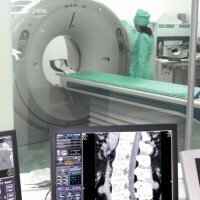Splenomegaly: Symptoms, Causes, Diagnosis, and Treatment
 Splenomegaly is a pathology, not an independent disease. This pathology is manifested by changes in the size of the spleen. It can indicate the presence of various diseases and health problems. Therefore, when enlarging the spleen, it is necessary to consult a doctor and find out the cause of what triggered it.
Splenomegaly is a pathology, not an independent disease. This pathology is manifested by changes in the size of the spleen. It can indicate the presence of various diseases and health problems. Therefore, when enlarging the spleen, it is necessary to consult a doctor and find out the cause of what triggered it.
Often, splenomegaly manifests itself with enlarged lymph nodes. Lymph nodes can increase due to increased destruction of cancer cells, due to infectious inflammation, and also due to cancer. To determine that the spleen is enlarged in size is not difficult. This can be done by ordinary probing. If the doctor determines that the organ is enlarged, he may prescribe an additional examination and prescribe a tomography or radionucleid scan.
Causes of enlarged spleen
Unfortunately, enlarged spleen does not say anything good. Very often, the cause of an increase in this body is the presence of serious diseases. If the spleen is too much increased in size, then this may be due to chronic myelogenous leukemia, lymphocytic leukemia, myelofibrosis, non-Hodgkin's lymphoma, polycythemia and other diseases. In addition, the spleen can increase due to cirrhosis at a late stage. Signs of cirrhosis are edema of the legs, jaundice, fluid accumulation in the abdominal cavity, enlargement of the liver. Patients with this disease develop hepatic encephalopathy, which is manifested by a decrease in the level of consciousness and illegibility of speech.
The emergence of stagnant splenomegaly can cause thrombosis of the splenic vein or individual vascular malformations. In addition, the spleen can increase with severe forms of brucellosis. This disease is rare, but dangerous. The first symptoms of brucellosis are weakness, headache, sweating, nausea, back pain, fever. In the late stages of the disease, the liver and spleen increase in size.
Various inflammatory and infectious diseases can cause enlarged spleen. Most often it provokes acute infections. For example, amyloidosis, infective endocarditis and the like. Accumulation of abnormal amyloid protein in the spleen can also provoke its increase. In this case, the symptoms of the disease can manifest themselves in different ways. Sometimes doctors diagnose kidney failure, which manifests itself in the form of a lack of urine. Heart failure may appear in the form of dyspnoea and tachycardia. Even problems with the gastrointestinal tract can cause augmentation of the spleen.
Chronic infections sometimes cause enlargement of the spleen. Also, connective tissue diseases and sarcoidosis can lead to the development of this pathology. In patients with endocarditis, spleen often increases in the second or third week. In this case, the patient also has other symptoms, characteristic of the disease.
Rheumatoid arthritis involves a host of symptoms, including an enlarged spleen. Splenomegaly can be caused by malaria. But the increase in the spleen in this case will be revealed before the onset of fever.
Lipid and non-lipid diseases can lead to the development of pathology. In particular, this is a violation of protein metabolism, Leterer-Sioux disease, Hyunda-Schüler-Krisscher disease, a violation of protein metabolism. This pathology is most often triggered by the spleen cyst, which arises from the destruction of the previous hematoma. In the early stages of chronic or acute leukemia, the spleen can also increase.
Patients with viral hepatitis face a pathology such as splenomegaly. With this disease, not only the spleen but also the liver increases, and also jaundice, nausea, fever, vomiting, weakness, and temperature.
Very rarely, the enlargement of the spleen provokes such a rare fungal infection as histoplasmosis. In this case, most often the spleen increases in size with disseminated histoplasmosis. In addition to this symptom, other symptoms are pronounced in patients: lymphadenopathy, exhaustion, weakness, fever, anemia. In rare cases, the larynx, the tongue and the sky are covered with sores, which leads to a painful swallowing and hoarseness of the voice.
Symptoms of splenomegaly
Symptoms of splenomegaly will only occur when the spleen is greatly enlarged in size. Symptoms will be associated with the spleen capsule stretching and squeezing the surrounding organs. Because of this, the patient will be bothered by bloating, constipation, aching pain in the region of the left hypochondrium. If the patient presses on the stomach, then he will have a feeling of fullness of the stomach and immediately lose his appetite. In addition, a person will be troubled by heartburn.
This is not the whole list of symptoms of splenomegaly. After all, as mentioned above, splenomegaly is not a single disease, but only one of the symptoms of the disease. Therefore, a person who has this pathology will experience other symptoms of the disease, which is the reason for the increase in the spleen.
Diagnosis of splenomegaly
Before diagnosing the disease, the doctor carefully listens to all the patient's complaints. Then the doctor will try to understand what disease could provoke the development of splenomegaly. The doctor may ask how long the symptoms started, what caused their appearance, and so on. Also, without fail, the doctor must be informed if you have visited exotic countries. It is necessary to mention all bad habits( smoking, drinking alcohol), about the diet.
It is very important for a doctor to know whether relatives of a sick spleen, blood, GIT or liver disease. After all this information, the doctor spends a feeling of the spleen to determine how much it has increased in size. Thanks to palpation, the doctor will be able to understand what the density of the spleen tissue is and how painful the pressure is on it. Then the doctor will recommend the patient to undergo additional examinations. Assign such tests: biochemical blood test and clinical analysis, coprogram, general urine analysis, coagulogram, analysis of feces for eggs of worms, a blood test to identify the pathogen. Ultrasound of the abdominal cavity, sternal puncture, computed tomography, genetic studies, autoimmune biochemical markers can also be prescribed.
Treatment of splenomegaly
Treatment of this pathology is always complex. After all, it is aimed not only at eliminating the main symptom( enlargement of the spleen), but also on the treatment of the disease, which entailed splenomegaly. In especially severe cases, the enlarged spleen is surgically removed. Surgical treatment is indicated for thalassemia, Gaucher disease and hairy cell leukemia. After the removal of the spleen, the patient is more susceptible to meningococcus, hemophilic rod and pneumococcus. This is why, before removal, the patient is given appropriate vaccinations to reduce the risk of negative consequences.
Prevention of splenomegaly
Since splenomegaly is not an independent disease, there are no specific preventive measures against it. But doctors recommend to abandon bad habits, since they often provoke an increase in the spleen. Before traveling to exotic countries, you must necessarily make all the vaccinations. The moderate physical load will also benefit. It is equally important to undergo routine examinations with doctors.



